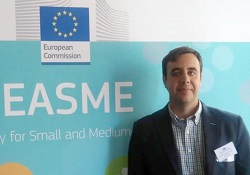Improved polyphenol extraction thanks to ultrasounds
Vine growers and wine amateurs know all about them: polyphenols are the most important flavour chemicals in red wine, and have been found in numerous epidemiological studies to help prevent vascular disease, cancer or diabetes. They give wine its much-appreciated colouration, and can even influence the aftertaste and body. With the ULTRAWINE (Eco-innovative maceration system based on LFHP ULTRAsound technology for WINEmaking) project, Ricardo Jurado and his team have created a technology that will help vineries produce a high-quality wine with high polyphenolic content, intense colour and great aroma, in less time and with less energy input than ever. Their low frequency high power (LFHP) ultrasound equipment, which is designed to optimise the extraction of phenolic compounds from grape skins during the first stages of winemaking, promises the completion of the grape maceration process in 6 hours instead of 4 days, with 30 times less energy being consumed and the ability to process three times more grapes. How did you achieve acceleration of the maceration process? We used the cavitation phenomenon. Cavitation consists in the formation and sudden implosion of gas bubbles in a liquid. Each bubble undergoes compression and rarefaction. This causes the bubbles to implode, in turn generating enormous pressure that destroys the cell wall and allows the phenolic compounds to migrate to the liquid medium. Although different techniques, such as thermovinification, cryomaceration or flash détente have been developed with the same objective of enhancing the extraction of phenolic compounds, our device presents interesting advantages over all of them. What are these advantages? First, cavitation is a time saving process: Thanks to ULTRAWINE technology, extraction is completed within a few hours whilst maceration takes several days. Then, we use the cold extraction method, which means that there is no temperature increase during the treatment, and no production of hydroxymethylfurfural (HMF). Our device also presents significant energy advantages compared to alternatives since it requires neither refrigeration like cryomaceration (cold production is one of the most expensive processes of the food industry), nor heating like thermovinification or flash-détente do. This, along with the fact that there are no waste products specific to ULTRAWINE technology, makes for an environment-friendly process. Finally, we have more aromatic wines and faster clarifications thanks to the use of ultrasounds. What about the quality of the end-product? ULTRAWINE uses a technology that is totally respectful of grape variety, because it is a non-thermal treatment based on a physical process which avoids the appearance of undesirable organoleptic attributes. Besides, thanks to the increasing processing capacity of the winery, grapes can be processed at its perfect point of ripening. What has been the feedback from potential customers so far? The wineries having tested ULTRAWINE have confirmed the aforementioned advantages, along with the fact that installation and handling are easy, and that our device saves space thanks to its small dimensions. In fact, winemakers have been acting as promoters of this great project: they were the ones calling for an equipment capable of improving the extraction of polyphenolic compounds in a short period of time with the least economic expense. What did you achieve thanks to EU funding? The SME INSTRUMENT has allowed AGROVIN to fully develop its ultrasound equipment. The funding has also been invested in dissemination activities, in the establishment of a commercialisation plan and in assuring the protection of the industrial property of the equipment and its working mechanisms worldwide. How do you plan to further promote your equipment? We believe in the technique’s potential and, therefore, we are investing high economic and human resources on it. The commercialisation strategy includes different actions, notably training our commercial department, organising presentations of the technology at wineries, participating in important forums and fairs, ensuring media coverage, and remaining active on social media. When do you expect the ULTRAWINE technology to be commercialised and what are your mid- to long-term objectives in terms of success? Prior to its commercialisation, ULTRAWINE’s technology must be authorised within the wine sector. The OIV (International Organisation of Wine and Vine) is the internationally-recognised organisation in charge of accepting new technologies, and will have to authorise the use of our technology in the sector before we can commercialise it. Currently, the technology is in phase 3 out of the 7 required by the OIV’s procedure to obtain its legal status. Once we obtain the OIV approval, AGROVIN’s commercial efforts will be intensified. But we already expect to obtain a wide acceptance in wineries, considering the positive results already obtained. ULTRAWINE Funded under H2020-SMEINST-2
Countries
Spain



